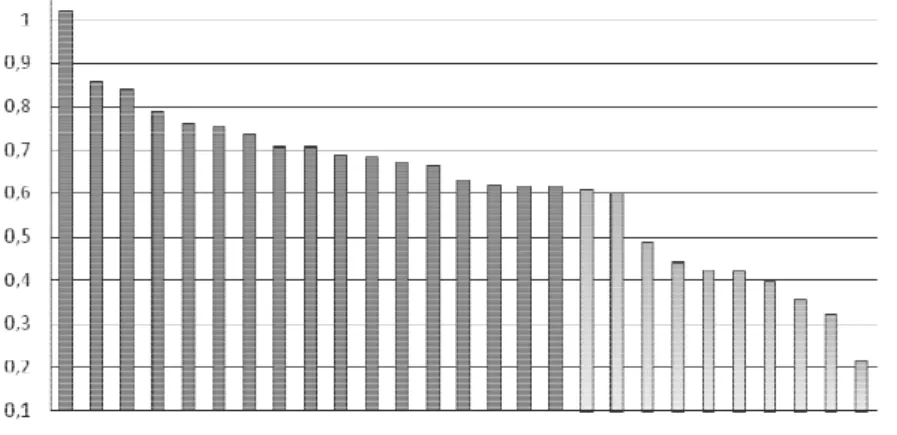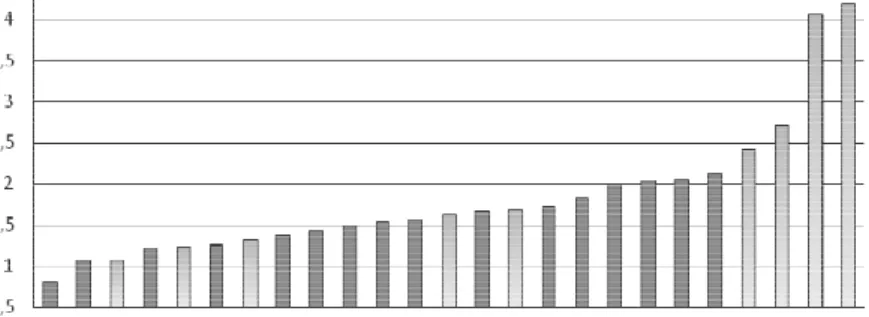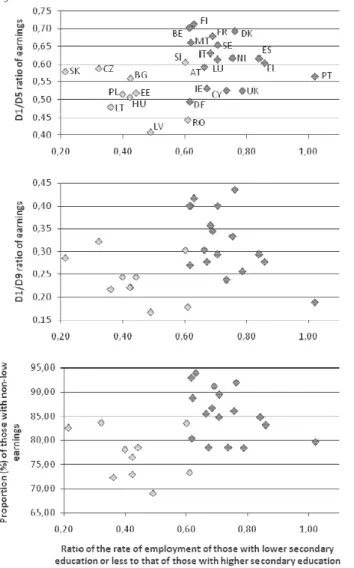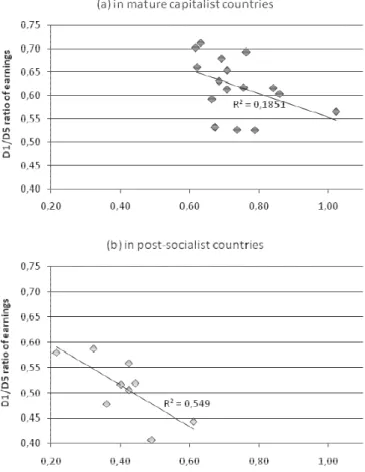ON THE PECULIAR RELEVANCE OF A
FUNDAMENTAL DILEMMA OF MINIMUM-WAGE REGULATION IN POST-SOCIALISM – APROPOS OF AN INTERNATIONAL INVESTIGATION
ISTVÁN R. GÁBOR1
ABSTRACT To the extent minimum-wage regulation is effective in fighting against excessive earnings handicaps of those at the lower end-tail of earnings distribution, it may have the side-effect of worsening their employment prospects. A demand-and- supply interpretation of data on the relative employment rate and earnings positions of the least educated in the EU27 suggests that the resulting dilemma might be particularly relevant for minimum-wage policies in post-socialist countries.
KEYWORDS minimum wage, earnings dispersion, demand and supply of labor, wage and employment discrimination
THE DILEMMA
Minimum-wage regulation is a notoriously controversial issue among economists. So much so that about any pro invites a con, with periodic shifts in emphasis.
Were one professing, for instance, that minimum-wage regulation may serve well as a helping hand for those who are at the lower tail-end of the earnings distribution for lack of bargaining strength, someone else would readily bring up some market-distortion kind of counter-argument – say that minimum-wage regulation, by hurting non-union competition against union firms, tends to strengthen even further the excessive bargaining power of those employed at union firms.
Advocates of minimum-wage regulation as a policy tool in fighting against
1 István Gábor R. is a professor of economics at the Human Resources Department of Corvinus University of Budapest, e mail: igaborr@uni-corvinus.hu
FORUM
poverty would meet particularly vehement opposition. It is far too blunt an instrument, someone would immediately riposte, pointing to the high proportion of those at the bottom of the earnings distribution who are by no means poor. If still deployed, the riposte would go on, it may backfire:
it may worsen the chances of entering into gainful employment for exactly those who are meant to be helped (as it clearly did in Hungary, as shown by findings, reported by Köllõ (2010), of studies of the impacts of the 2001-2002 minimum wage hike).
How far this latter sort of counter-argument (and the dilemma of minimum- wage regulation policy it implies) is well-founded is not the issue I am going to discuss. What I want to demonstrate is that, to the extent there is any truth in it – and few would doubt that there is some –, it is particularly relevant for post-socialist countries, including my home country (Hungary).
If I am right in this supposition, an obvious corollary would be that lessons drawn from the experience of minimum-wage regulation in mature capitalist countries may not automatically/invariably apply to their post-socialist counterparts.
THE APPROACH
I was lucky enough to be an invited fellow attached to The Collegium Budapest Institute for Advanced Study when, in late 1994, Nobel Laureate Robert Solow delivered a lecture there on how simple tools of demand- and-supply analysis could help explain the tendency to increasing earning inequalities, as measured by the proportion of low-earners (earning below 2/3 of median) and various ratios of earnings deciles, that had been observed in the United States from 1975 to 1989 (Solow 1994). My contribution will, too, be based on a demand-and-supply kind of interpretation of similar indicators. At the same time, instead of trend-like evolution that may or may not be common to several countries, my contribution will address the apparent distinctness of post-socialist vs. mature capitalist member-countries of the EU27, as is attested by figures calculated from EUROSTAT employment data and OECD earnings data for the year 2006.
Furthermore, my exposition will mirror-image Solow’s in that, while he started out from data on earnings dispersion, and turned to data on the unequal opportunities for employment only as a second step, I will follow the opposite route. The reason for this is purely pragmatic. It is motivated by today’s convention of setting goals in terms of employment opportunities rather than of earnings dispersion, at domestic as well as international forums.
THE FACTS
As is immediately apparent from an inspection of Figure 1, post-socialist member-countries in the EU27 consistently lag behind the mature capitalist group with respect to the ratio of the employment rate of the least educated (those with lower secondary education or less) to the rate of employment of those with upper secondary education. Ranked according to this ratio, post- socialist countries, with no exception, are placed as file-closers.
Figure 1 Ratio of the rate of employment of those with lower secondary education or less to that of those with uppe secondary education within the 25-64-year-old population in the EU27*
*Member-countries in alphabetical order (with their abbreviations in brackets): Austria (AT), Belgium (BE), Bulgaria (BG), Cyprus (CY), Czech Republic (CZ), Denmark (DK), Estonia (EE), Finland (FI), France (FR), Germany (DE), Greece (EL), Hungary (HU), Ireland (IE), Italy (IT), Latvia (LV), Lithuania (LT), Luxemburg (LU), Malta (MT), Netherlands (NL), Poland (PL), Portugal (PT), Romania (RO), Slovakia (SK), Slovenia (SI), Spain (ES) Sweden (SE), United Kingdom (UK).
Sources of data: http://epp.eurostat.ec.europa.eu/portal/page/portal/eurostat/home
In seeking to identify the origin of their lagging position, one might hope to get some clue from ranking the same countries according to their analogously-defined relative unemployment rates, as is illustrated in Figure 2. This additional ranking, however, is of not much guidance.
Figure 2 Ratio of the rate of unemployment of those with lower secondary education or less to that of those with upper secondary education within the 25-64-year-old population (without Estonia and Malta, for lack of data on education-specific unemployment)
Sources of data: see Figure 1.
True, it does not yield nearly as unambiguously distinct, complementary patterns of positions of the respective country-groups as did our previous ranking. Nevertheless, it does not follow that supply-side factors are to be blamed in the first place.
To wit, as any freshman going through an intro-to-microeconomics course would soon learn, supply and demand are – unlike our ratios of relative (un)employment rates – not scalars, simply measurable as (derivatives of) physical quantities, but sets of vectors of some kind of physical quantities and corresponding prices, and, therefore, can only be illustrated in a meaningful way in a two-dimensional, price-quantity space. In Figure 3, accordingly, the relative employment rate of the least educated of each country is plotted against some (imperfect) measure of the size of the least-educated/more- educated earnings gap – a reasonable approximation of the price ratio of least educated/more educated labor –, which, in turn, are, as a matter of fact, strongly influenced by the level of the minimum wage (as is demonstrated by Grimshaw (2010) in his comparative report, where a negative cross-country relationship, with R2=0.59, is reported between the minimum wage/average earnings ratio and the proportion of low-earners).
Interpreting the resulting plots in supply-and-demand notions, reasoning may go like this:
To the extent that consistently lower relative employment rates of the least educated in the post-socialist region were due to lower relative supply of labor
among the least educated population of working age, better earnings positions for the low-educated (and narrower earnings differentials arising therefrom) should simultaneously be observed in that region – just the contrary to what Figure 3 attests.
Figure 3 Earnings inequality among full-time employees, and the relative rate of employment of the lowest educated
Sources of data: http://epp.eurostat.ec.europa.eu/portal/page/portal/eurostat/home for employment and http://stats.oecd.org/Index.aspx for earnings dispersion figures.
What we see is that under post-socialist conditions the least educated are doubly disadvantaged as compared to their peers in the mature capitalist world: they are hit by both consistently lower rates of employment and lower relative earnings – an unambiguous syndrome of lower relative demand for their labor.
CAUSES AND CONSEQUENCES
What aspects of post-socialist capitalism should be blamed for this lower relative demand? It is beyond me to present the answer. But generalizing from findings of János Köllõ’s studies of the Hungarian case (Köllõ 2009), the following three aspects of post-socialist evolution come to mind as the most obvious immediate causes: (1) an exaggeratedly fast rate of education- biased technological development (relative to the evolution of educational composition of the working-age population); (2) a widening gap between the least educated and the more educated in marketable competencies and skills;
and/or (3) a relative abundance of formally skilled labor with obsolete skills at the initial stage of post-socialist transition, which gave rise to a tendency of favoring over-qualified job applicants in employers’ hiring strategies.
More relevant to the main thrust of my contribution than getting deeper into the causes is to complete the list of consequences. In addition to a lower relative rate of employment coupled with lower relative earnings of the least educated, at least one more dual consequence needs to be spelled out. Namely, that lower relative demand for this category of labor provides a fertile ground for the proliferation of discrimination, be it prejudice-induced or statistical, while biasing its form of manifestation from wage discrimination (a relatively innocuous form) towards employment discrimination - a more blatant and socially more destructive form.
CONCLUSION
Let us take one more look at our two-dimensional plots – or, better, at their variant in Figure 4, where data points of the two groups of countries are put in separate graphs, and regression lines, conceived as representations of some kind of country-group level quasi-demand functions, are fitted to the data points of the respective groups. In order to save space, from among our three measures of earnings dispersion only data on the D1/D5 ratio are exploited (nothing qualitatively different would have emerged from the other
two measures). Besides, Germany, for not being either mature capitalist or post-socialist in its entirety, is dropped, and so is Slovenia as an outlier according to several more economic indicators than only those of interest to us here (country markings themselves are dropped, for the sake of better visual transparency).
Figure 4 Earnings inequality among full-time employees and the relative rate of employment of the least educated
Sources of data: see Figure 3.
The Figure speaks for itself. The seemingly inferior (i.e. closer-to-the- origin) position of the post-socialist quasi-demand curve, while it implies more acute need for minimum-wage regulation, given the more disadvantaged earnings position of the least educated, also implies more acute danger of an employment kickback, given the lower relative rate of employment of the least educated. Under the conditions of post-socialism, moreover, relative earnings and employment of the least educated are seemingly much more tightly correlated (cf. the respective values of R-squared in the Figure), i.e.
the inevitability of painful trade-offs must be far more obvious.
Similarly more conflict-loaded in the post-socialist region is the impact of minimum-wage regulation on discrimination. Greater earnings handicaps, arising from the generally wider dispersion of earnings, of those who are discriminated against are a telling argument for the deployment of minimum- wage regulation in this region. No less telling is, on the other hand, the counter-argument which warns that, to the extent minimum-wage regulation does reduce discriminatory earnings differentials, it may induce a higher incidence of employment discrimination: the creaming off of workers who either belong to more favored groups or are over-qualified for unskilled jobs – employers’ practices that hurt the least educated the most.
To sum up, under the conditions of post-socialist capitalism, systematically lower relative demand for the least educated category of labor does, indeed, seem to make the fundamental dilemma of minimum-wage regulation distinctly more conflict-loaded and, thus, particularly relevant – with as yet unknown differential impacts on post-socialist minimum wage systems and industrial relations.
REFERENCES
Grimshaw, Damian (2010), Minimum wage systems and changing industrial relations in Europe. Comparative report. http://www.mbs.ac.uk/research/europeanemployment/
projects/minimum-wage.aspx, p. 4.
Köllõ, János (2010), Hungary: The consequences of doubling the minimum wage. In:
Daniel, Vaughan-Whitehead ed., The minimum wage revisited in the enlarged EU, Edward Elgar – International Labour Office, pp. 245-273.
Köllõ, János (2009), A pálya szélén. Iskolázatlan munkanélküliek a posztszocialista gazdaságban. (On the margin at the playfield. The unschooled unemployed in the post-socialist economy), Budapest, Osiris, pp. 236.
Solow, Robert M. (1995), Understanding increased inequality in the U.S. Public Lectures No. 4, Budapest: Collegium Budapest/Institute for Advanced Study, December, pp. 12.



